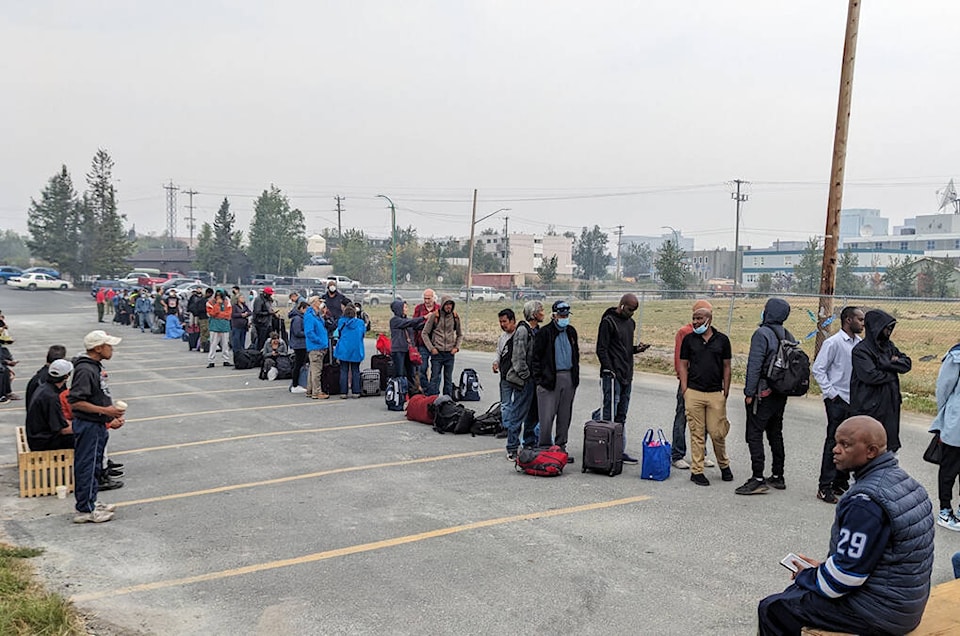What some might call a perfect storm of weather conditions will challenge firefighting efforts across British Columbia during the next two days, as the province expects to receive 55 evacuees from the Northwest Territories, with more on the horizon.
Emergency Minister Bowinn Ma issued the warning during her weekly update Thursday morning (Aug. 17). Health minister Adrian Dix and Forests Minister Bruce Ralston also participated.
Ralston opened the update with an acknowledgment of the situation in the Northwest Territories, which he described as a “rapidly evolving situation.” He then warned of “difficult days” ahead in the face of changing conditions.
“We are preparing for our own extreme fire behaviour this week due to the convergence of dry lightning, strong winds and drought conditions,” he said.
Senior provincial emergency staff including Cliff Chapman, director of wildfire operations with the BC Wildfire Service; Jonathan Boyd, hydrologist with River Forecast Centre; and Connie Chapman, acting director of the water management branch with the Forests Ministry, joined the ministers during the update.
Cliff Chapman echoed Ralston’s warnings.
“This weather event has the potential to be the most challenging 24 to 48 hours of the summer from a fire perspective,” he said. “We are expecting significant growth and we are expecting our resources to be challenged from north to south over the next 48 hours.”
Chapman said those new fires will even challenge air tankers, helicopters, as well as ground resources.
The warnings about new fires sparked by lightning cover all of British Columbia including Metro Vancouver, Vancouver Island and other coastal regions. Chapman said new fires are expected to start in the north, then sweep through the Cariboo region into the southern parts of the province.
Of the 14 ‘notable’ wildfires, eight are burning in the Kamloops Fire Centre with two more in the Southeast Fire Centre, according to BC Wildfire Service, Thursday morning.
Notable additions in the last 48 hours include the Crater Creek fire with a size of 10,000 hectares burning 18 kilometres southwest of Keremeos in the Similkameen and the McDougall Creek fire with 64 hectares burning 10 kilometres northwest of West Kelowna in the Okanagan.
The fast-moving, fast-growing fire near Keremeos prompted a spectacular evacuation of more than 100 individuals camping and working at Cathedral Provincial Park. Residents in other nearby areas also had to leave their homes. The fire near West Kelowna forced authorities to put some 4,800 properties in the area on evacuation alert. Depending on wind conditions, alerts could turn into orders, Chapman said.
“Please be ready for the evacuation alert to potentially become an order over the course of today, tomorrow…,” he said.
Both Chapman and Ma underscored the seriousness of the situation by urging residents regardless of where they live to follow evacuation orders.
“(I) want to emphasize that an evacuation order is not the time to wait and see, especially not under the conditions that are being forecasted,” Ma said. “Be prepared now. Have an emergency plan and a grab-and-go kit ready for your family and your pets.”
Ma also urged organizers of music festivals and other events to have an emergency plan in place. “It’s incredibly important that local authorities not be surprised by the presence of hundreds or thousands of additional visitors in their region during an emergency situation,” she said.
RELATED:
RELATED:
If senior provincial authorities are monitoring the situation across the province, they are also paying attention to developments in the Northwest Territories with the focus being Yellowknife.
Its 20,000-plus residents have started to leave that city after authorities in the Northwest Territories Wednesday had issued an evacuation order as wildfires are approaching.
Streams of vehicles could be seen leaving the community under smoke-filled skies for safety in neighbouring but distant Alberta with British Columbia also expected to receive evacuees.
The scope and the speed of fires approaching Yellowknife and other communities has revived memories of the 2016 wildfires, which swept through Fort McMurray. It is now among the communities receiving evacuees, who are either travelling by plane or vehicle across distances through remote wilderness for safety.
Hundreds of wildfires are currently burning across the territory, having already destroyed homes. Federal authorities as well as provincial authorities from Canada’s western provinces including B.C. are currently coordinating assistance.
Premier David Eby Wednesday pledged that B.C. will offer all available support to its northern neighbour and Ma repeated that promise, noting that B.C. is accepting patients.
But B.C. won’t provide firefighters to help fight fires in the Northwest Territories at this stage, given the current wildfire situation, Chapman added. That could change if the weather changes, he said.
RELATED:
RELATED:
Less ominous but hardly less serious is the current state of B.C.’s drought. Ralston said 28 out of 34 basins in B.C. continue to be at the worst or second-worst drought rating. He added that his ministry continues to monitor stream and river flows.
“The drought conditions in Bessette Creek and Salmon River, both of which feed into Shuswap Lake near Salmon Arm, are particularly concerning,” he said. Drought conditions in those rivers are putting trout and salmon stocks at risk, he added.
“That’s why I issued the fish population protection order for both Bessette Creek and the lower Salmon River area,” he said. The order under the Water Sustainability Act prohibits water use for forage crops, including grass or hay, but allows use for people, livestock, fruit crops and market vegetables.
RELATED:
wolfgang.depner@blackpress.ca
Like us on and follow us on .



